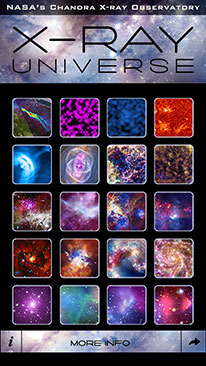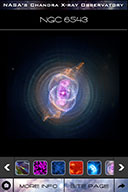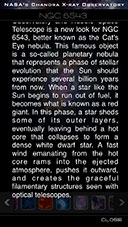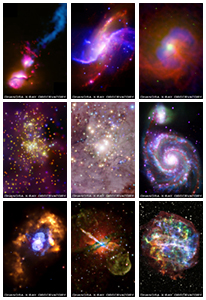Disclaimer: This material is being kept online for historical purposes. Though accurate at the time of publication, it is no longer being updated. The page may contain broken links or outdated information, and parts may not function in current web browsers. Visit chandra.si.edu for current information.

Images: (left-right; top-down:
Earth Aurora, Mars, Jupiter, Sun
Vela Pulsar Jet, NGC 6543, Cassiopeia A
Tycho's Supernova Remnant, NGC 281
Carina Nebula, Tarantula Nebula
Galactic Center , M83, M82, Antennae
M101, Abell 383, Abell 520
MACSJ0717.5+3745, 1E 0657-56)
System Requirements
* Apple iPhone
NASA's Chandra X-ray Observatory iPhone App


From exploding stars to black holes to clusters of galaxies, explore recent science highlights from NASA's Chandra X-ray Observatory. This app provides a selection of Chandra's astronomical images to zoom into, share, and learn about. Drawing directly from our database of Chandra observations, the Chandra team will be increasing the selection, and adding multiwavelength functionality and additional interactivity in future updates.
About the Chandra mission: Since its launch on July 23, 1999, the Chandra X-ray Observatory has been NASA's flagship mission for X-ray astronomy, taking its place in the fleet of "Great Observatories." Chandra has imaged the spectacular, glowing remains of exploded stars, and taken spectra showing the dispersal of elements. Chandra has observed the region around the supermassive black hole in the center of our Milky Way, and found black holes across the Universe. Chandra has traced the separation of dark matter from normal matter in the collision of galaxies in a cluster and is contributing to both dark matter and dark energy studies. As its mission continues, Chandra will continue to discover startling new science about our high-energy Universe.

Images: (left-right; top-down:
3C321, NGC 4258, NGC 4696,
Wd2, Orion Nebula, M51,
Eta Carinae, Centaurus A, G292)
System Requirements
* Mac OS X 10.1 or later
* Apple iPhone and Mac OS X with iTunes
Chandra X-ray Observatory iPhone Wallpaper
Chandra’s unique sensitivity and resolving power have made possible significant advances in many areas of astronomy. And, when Chandra’s X-ray observations are combined with data from other telescopes, an even more compelling view of the cosmos can be constructed. These iPhone images feature many objects where the power of astronomy in different wavelengths can be admired and the unique role of X-ray astronomy can be appreciated.


